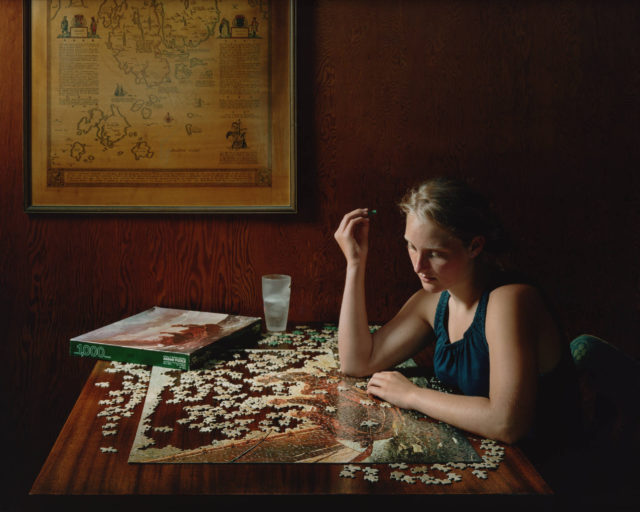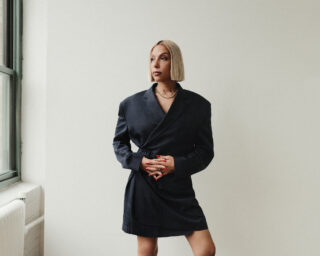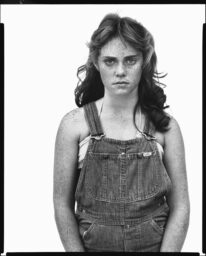An Artist’s Video Choir Tells a Story about Black and Queer Visibility
Michèle Pearson Clarke tests the limits of vulnerability before the camera—and creates a novel vision of queer solace.
Michèle Pearson Clarke, Still from Quantum Choir, 2022
Four-channel 4k video installation at the Art Gallery of Hamilton, Ontario, Canada
Bad singer? Check. Queer female masc? Check. Game to explore both? Check.
On July 15, 2021, I was scrolling through Facebook when I saw a post by Toronto artist Michèle Pearson Clarke announcing a new project about learning to sing. She needed three game participants who fit the above criteria. I stopped in my tracks and immediately answered her invitation because, yes, that’s me.
I am indeed both a bad singer and on the spectrum of queer female masculinity, so I was fully confident in my fit for Michèle’s Quantum Choir. I was also thoroughly discomfited by what it would ask of me. I’m an objectively awful singer: memories of being instructed to lip-sync in my elementary-school choir still haunt me. And this is precisely why I responded to Michèle with lightning speed: I worried that if I had time to think about it, I’d back out. I had a strong desire to embrace what terrified me and reminded myself that I had nothing to lose but face. And in my forty-eight years I’ve learned that saving facing is overrated, anyway.
There were other reasons for my yes. I admire and respect Michèle’s work, so I welcomed the opportunity to create something with her. And as a writer and photographer who asks people to say yes to sharing parts of themselves with me, I want to offer my own yeses in turn. I also learned that our professional vocal coach would be Teiya Kasahara—not only a supremely talented soprano (and currently a Disrupter-in-Residence at the Canadian Opera Company) but also a former soccer teammate. In short, I knew that despite my trepidation (okay, terror), this would be a unique and compelling learning experience, no matter the outcome.
There was joy in being a complete amateur, in playing around in the sonic sandbox, in letting go, or attempting to let go, of my perfectionism, in having no control over the final product. I knew that, with Michèle and Teiya, I was putting myself—and my voice—in safe hands. My work was the process of learning to sing one song over the span of a few months. The process was the thing, not the product, not perfection.
I spent a few months learning John Grant’s “Queen of Denmark,” which is an incredibly challenging song to sing because it’s quiet, it’s loud, it’s low, and it’s long. I learned that I’m an alto (no matter how much I’d love to be a tenor). I learned new vocabulary as I worked with Teiya to train my voice as a muscle. I also learned new ways of thinking about my body. I can now utter such phrases as “I’m working on my diaphragmatic breathing” and “inviting resonance from my nasal cavity and occipital bones” and “projecting sound at a forward angle” and know what they mean (sort of).
For Quantum Choir, part of Michèle’s first major solo exhibition, Muscle Memory, currently at the Art Gallery of Hamilton in Ontario, success meant showing up, being curious about the work, and, in the end, performing for her camera. Getting through the song was the goal. There was a freedom in not needing to be good, in not needing to be attached to outcomes. At the same time, I wanted, desperately, to not entirely embarrass myself in the final piece. There wasn’t enough time to excel, but I wanted to sound less bad in the end. Between weekly lessons with Teiya and daily solo practices (including recording my solo renditions of the song so I could hear myself in playback), I did get better.
Now that the practicing is over, the recording is behind me, and the video installation is live, I look at the performance with some pride. There are moments when I don’t cringe at the sound of my own voice. Seeing Michèle’s final edit, her making the four of us a choir on massive screens, was unlike anything I’ve experienced. My partner watched it multiple times, from different angles, and said (through her femme tears) that it was “hugely moving to be with butch fierceness and vulnerability.” Other members of our queer community thanked us for offering a reflection of themselves on screen. It has been a telling reminder that butch representation matters, and that despite our legibility, there is a continued erasure of us in the culture at large.
I began this project confident in who I am as a masculine-of-center woman with deep awareness of myself as a terrible singer. But one of the biggest takeaways for me is that I sound better if I act like I’m good at it: if I really give it in performance and pretend I’m a superstar. Not holding back meant simultaneously carrying confidence and vulnerability, singing badly with shoulders back, head high, lungs full, voice loud.

Kerry Manders: Where did the idea for Quantum Choir come from?
Michèle Pearson Clarke: Quantum Choir arose from me thinking about my process and coming to understand that I’m not a good judge of what other people are willing to do in and for my artwork. I’ve made this repeated artistic gesture of asking community members to be vulnerable before the camera, but then a few projects fell apart or needed to be changed quite significantly because nobody was willing to do what I was asking.
Quantum Choir emerged from this question: What is my line in the sand? What would push my limits? How do I lean into discomfort? What would it look like to make a project addressing my greatest source of vulnerability? It was clear immediately that this meant singing because I’ve had this lifelong shame about my singing voice.
Manders: How do you feel about your singing voice?
Clarke: Until Quantum Choir, I’d never sung publicly in my entire life. I’ve always avoided it in every single situation that required it—whether it was “Happy Birthday” or the national anthem. I would mouth the words to appear as though I’m participating. A few years ago, I thought about taking singing lessons to overcome my fear, but even the idea of singing in front of a teacher felt daunting and embarrassing. And I started thinking about this in relation to queer female-bodied masculinity. Is the vulnerability that I was feeling about singing just personal, or was it rooted in something larger? I wanted to combine the personal and the cultural context—to invite us to think about these issues more broadly.
Because part of the shame I feel about singing is rooted in a gendered childhood memory: I went to an all-girls school where choir was very popular—a very “cool girl” thing to do. But I couldn’t sing, so I couldn’t join. There is a very real feeling of failure tied to this girlhood memory that steered Quantum Choir.
Manders: That’s a visceral memory of being a girl who failed and, in a way, a failed girl.
Clarke: That’s the link for me to notions of queer failure and its relationship to female masculinity. But that memory is also linked to being shaped by a Trinidadian culture of performance and wit, of natural entertainers, of enthusiastic dancers, of loud voices, of engaging storytellers. So, it’s interesting for me to feel like a failure at this particular performance thing—singing. So many of us understand what it feels like to be a failure at singing. I hope people can tap into that when they watch us try to do it. I hope I’m touching on both individual and larger cultural narratives around what it means not to be “good.”
Manders: The tensions and intersections between individual and larger cultural narratives are a big part of your work, which brings me to The Animal Seems to Be Moving (2018–23)—a striking title for a series of still images.
Clarke: Like several of my titles, it was inspired by something I was reading. I was thinking about the ways in which the Black male body is often seen as beastly, animal-like; and I was thinking of how my self-portraits are documenting a transition period in my life. There’s a sense of motion and movement over time in them.
This project is about aging, the shift in my appearance, and the shift in responses to my appearance. I’ve always been read as younger than I am, and now, whatever threat I present to some people seems to be increasing as I physically get older. I was also thinking about my own relationship to masculinity and the complex pleasure that has given me throughout my life. There’s something kind of primal in my sense of my own masculinity, particularly in the yearning. There’s a desire for certain experiences that I will never be able to have. As a female-bodied person, there’s a gap that can’t be bridged.
Manders: I’m thinking about your use of the words primal and animal and associating it with something forceful and fundamental. Often the human relationship to animals is one of paternalism, hierarchy, ownership.
Clarke: I’m always contending with those power relations given the history of visual representations of Blackness—the ways that photography has been complicit in constructing certain ideas of Blackness, and teaching us to see Blackness in certain ways, including seeing it as something to be conquered and owned. That history continues to provide violent and damaging assumptions about cis Black men, and those beliefs affect me as well, because of my masculinity.
No matter what your race is, we’ve all been fed certain visual representations of Black lives, and these continue to shape and influence the ways we make images.
Black masculinity is often deemed to be dangerous, brute, animalistic. And connected to these ideas is the assumption that we feel less pain. These dehumanizing stereotypes had specific and purposeful effects: to justify enslavement, to justify segregation, to justify torture, and they continue to be deployed to justify the disproportionate amount of force we face when we’re arrested.
Manders: That these ideas and stereotypes are still very current is a crucial aspect of your work.
Clarke: As a Black artist, I have to grapple with that representational history. I think of it as a thick filter that anyone looking at a contemporary image is necessarily looking through. That filter comprises nearly two centuries of negative images that we’ve all been exposed to. Those perceptions and representations get layered on top of contemporary images, and I question whether it’s possible to see a contemporary image of Blackness without these older ideas present. No matter what your race is, we’ve all been fed certain visual representations of Black lives, and these continue to shape and influence the ways we make images.
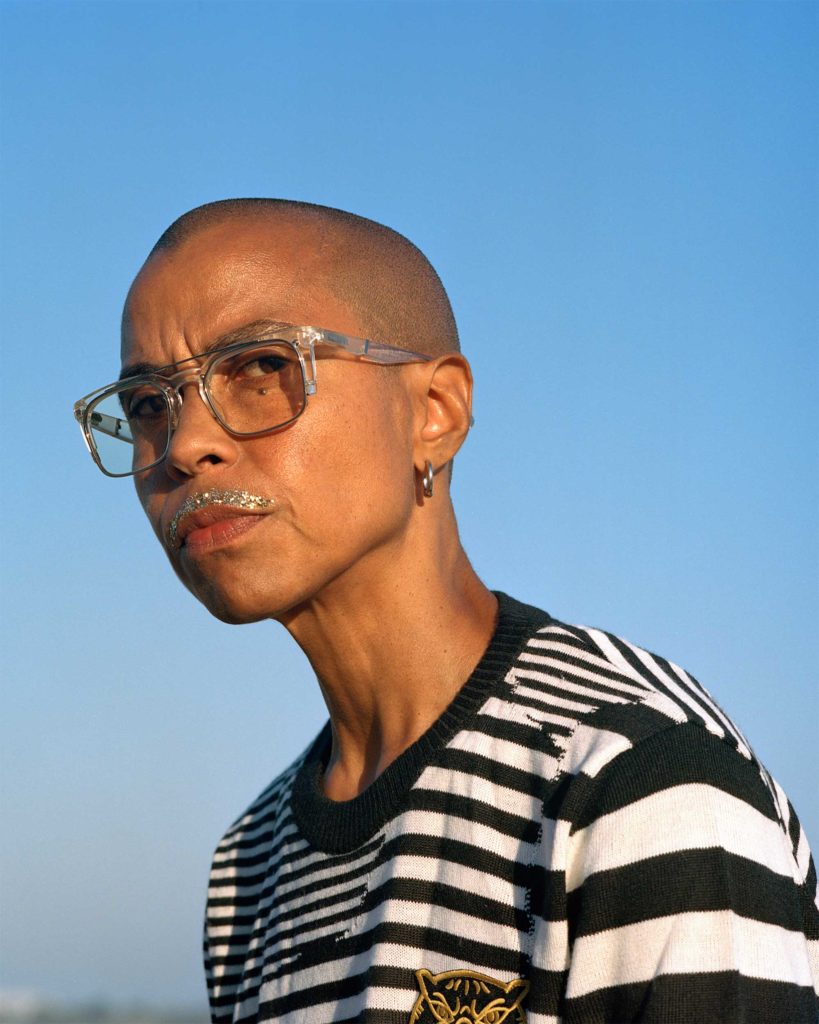
Manders: How do you contend with that racist history?
Clarke: To date, for me, the most effective strategy has been performance. I read Nicole R. Fleetwood’s Troubling Vision (2011) during my MFA studies, and her analyses of the relationship between performance, visuality, and Blackness were very compelling.
Also indispensable was Tina Campt’s Listening to Images (2017), in which she invites us to tune into the frequencies that affect how we see Blackness when we look. So, what we feel shapes what we see. Taking my lead from these scholars, I try to harness the affective qualities of performance—to shape a particular relationship to the visual content of the photograph.
I’m not necessarily trying to speak back to or against the history—to resist it. I don’t even use resistance anymore in descriptions of my work because that really frames what I’m doing in a binary relationship to an external anti-Black gaze. Instead, performance becomes a pathway to foreground my own pleasure and agency, to address my communities and to both reveal and withhold my experiences of being queer, being Black, being masculine. I’m good with being all those things. Any issues I have emerge from other peoples’ ideas about them.
With these self-portraits, I am really embracing humor and play as I perform for the camera. They are my attempt to speak to the absurdity of the way my Black masculinity is framed through those racist historical visual lenses.

Manders: At the Art Gallery of Hamilton, the self-portraits are in a room adjacent to our Quantum Choir video installation. Are there connections between these two parts of the show you call Muscle Memory? Did Quantum Choir grow out of the self-portrait work, as an extension of it?
Clarke: They’re connected to my rebuilding of self as I grieved my mother’s death over the past decade. As anyone who has been through the grief process knows, you can become unrecognizable to yourself along the way. Thankfully, I’ve recovered most of myself, I think, and part of that rebuilding has involved both my gender and my aging self.
This happened during a time of increasingly fraught cultural conversations about masculinities. About toxic masculinity. About trans masculinity and increasing visibility. About white masculine privilege. About Black masculinity and police violence. All these masculinities act upon my own masculinity and shape others’ ideas about me. Both The Animal Seems to Be Moving and Quantum Choir emerged from these broader reflections.
Manders: I’m curious about why you crafted a choir out of the idea of learning to sing.
Clarke: When I started to think about this project, I knew I wanted multiple people in it. All my work involves collectivity and kinship. I come from a community engagement background, and that always influences the way I work. And speaking against oppression, addressing difficult issues, doing hard things—all of these things are easier when you can do them with other people.
I’m also trying to say something about systemic issues rather than individual ones. Oppression is not a personal problem, it’s not unique to me. Taking an autoethnographic approach—making projects derived from my own experiences—but including other people who share those experiences is a strategic choice to avoid that reduction.
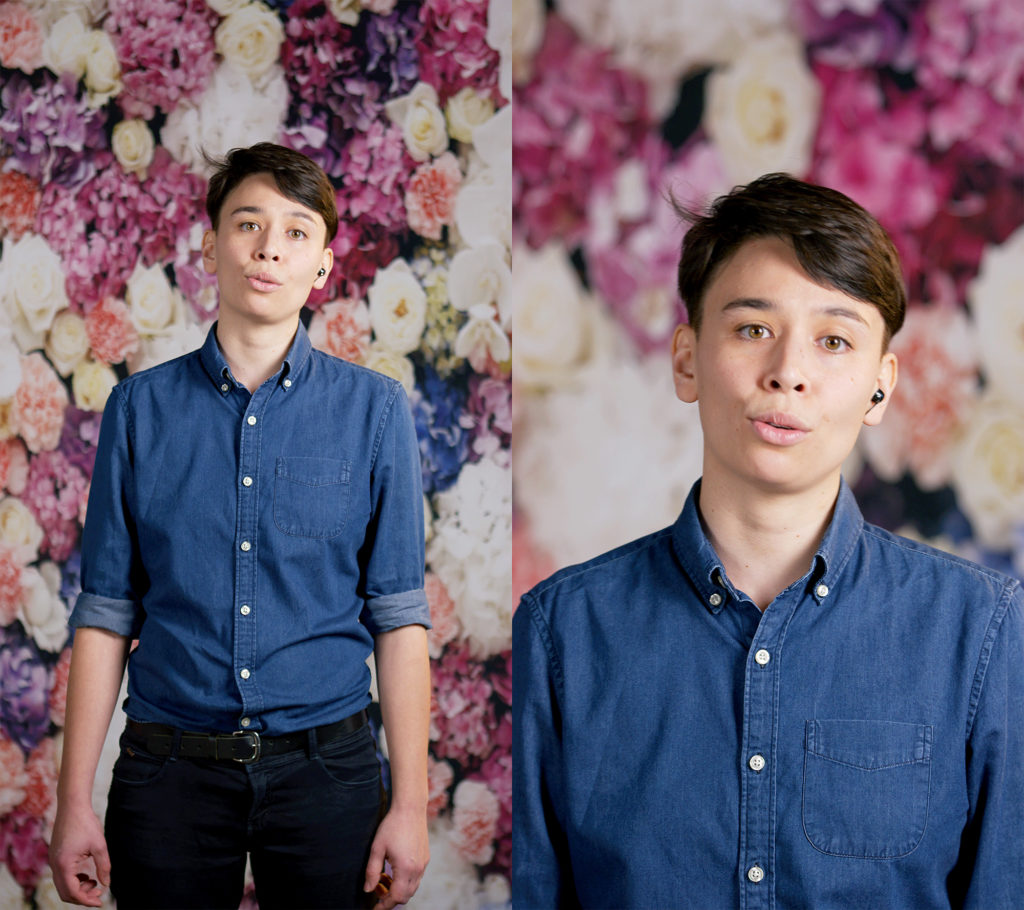
Manders: Four of us comprise Quantum Choir, but we didn’t actually sing the song together. We’re a bit of a paradox: a choir made up of solo performances. You say that doing a hard thing with others is easier, but we did most of the actual work separately. Can you talk about the balance between the individual and the collective aspects of this work?
Clarke: Practicing and filming individually was always the plan, because I wanted each of you to have your own experience of doing this very hard thing—your own vocal lessons, your own performance in front of the camera. I didn’t want you to have to worry about what anyone else was doing or to have to try to perform in any particular way.
Through my edit and the design and layout of the video installation, I was then able to construct and communicate collectivity—that’s in the very structure of the work. We become a choir in the way we address the viewer. But it felt important to keep the vocal lessons mostly private so that you would have your own relationships with our vocal coach, and we could learn the song in our own time and as we wanted, needed, and were able to.
We were all dealing with our own shame around our “bad” singing voices—I thought about what I was asking of you and what I’d want as a participant, and it wasn’t to feel shame in front of others all the way through. That would be adding another layer of difficulty.
Manders: It was difficult! When I first saw the artist statement for your exhibition, I had a very visceral reaction to the title, Muscle Memory. It felt incongruous to my experience: I have absolutely no muscle memory when it comes to singing!
Clarke: But you built some over the course of two months of lessons, right? The title Muscle Memory really ties both parts of the show together. Both look at female masculinity. One is about my own Black aging body, and the other is about the four of us learning to sing as a way to reflect on the vulnerability of visibly queer female masculinity.
The vulnerability in both projects has to do with the external gaze—the way people see me, see us. For any one of us who deals with hypervisibility in our culture, muscle memory develops as a response. Every time I leave my house, I adjust automatically to make myself as least threatening as possible. I’m always aware of others’ eyes on me. This lifetime of hypervisibility means that we’re used to being looked at and to being judged for how we look. Like, we walk into the women’s washroom and automatically code-switch—adjust ourselves, our bodies, to that space and what’s expected there.
Manders: Ah, yes, butch bodies in bathrooms. I find myself pushing out my chest a bit, so others can see that I have breasts and I might avoid the dreaded bathroom battle. When we were all at the AGH for that donor reception, I went to the washroom down the hall from Quantum Choir and got the familiar, “You’re in the wrong washroom, sir.” As soon as I spoke, the woman apologized. My speaking voice is a tell.
Clarke: Your body knows to expect that surveillance and has engrained reactions to it. It’s that automatic and repeated response: muscle memory as coping mechanism. And it’s so often a spatial thing for us. A lot of what I experience as a queer masculine person is about spatial discrimination—I’m not “supposed” to be in a women’s washroom, or I’m not “supposed” to move in a certain kind of way in a certain kind of place.
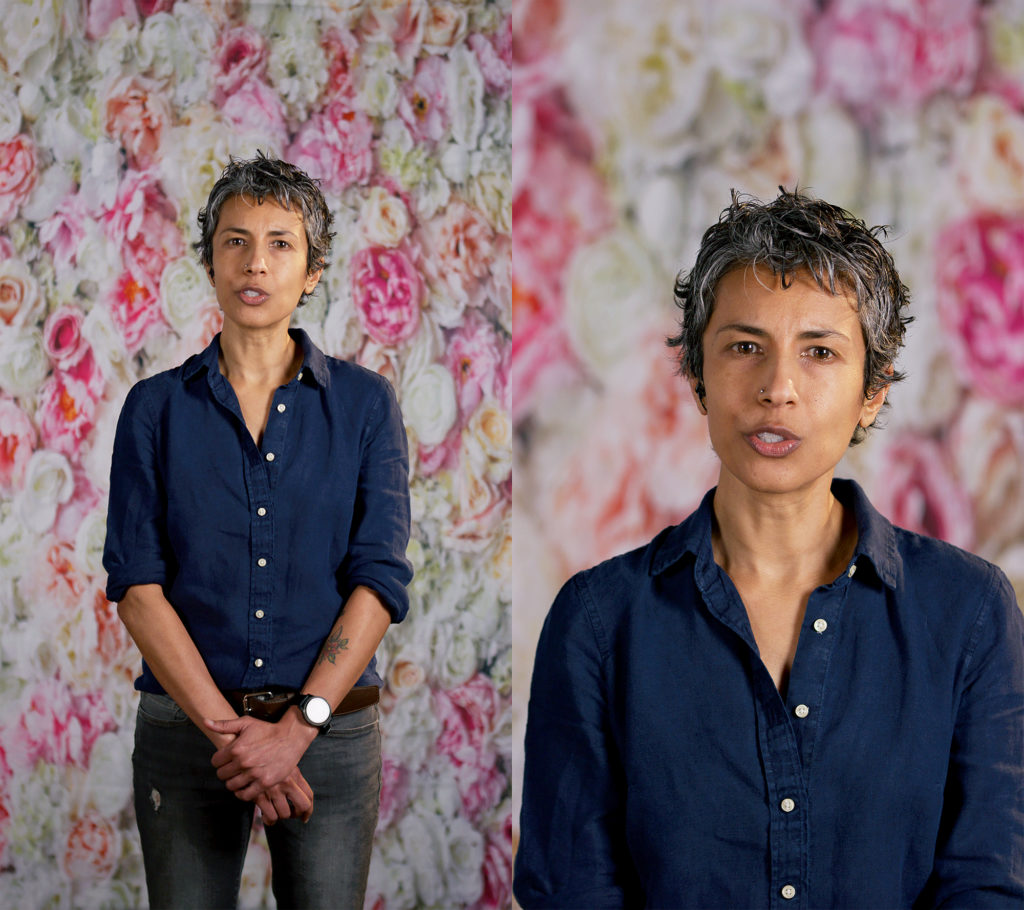
Manders: Like how we walk. Apparently, I have a sort of swagger when I walk, and I take long strides. I’ve been told my whole life that I don’t walk in a “ladylike” or feminine manner. I’m not a “proper” woman.
Clarke: As I mentioned earlier, the exhibition overall addresses that notion of queer failure. If models of success in our society involve heterosexual, white, able bodies, then Muscle Memory addresses the queer, female, masculine body as a subsequent failure. Queer theorists have invited us to think about this failure not as a space of deficit or negativity, but as a generative space that produces other ways of knowing, thinking, and feeling.
I accept that invitation in reframing the “failure” of my singing as an opportunity to generate something meaningful for me, for the three of you, and then hopefully for our audiences. I wanted to explicitly address the homophobia and the shame that the four of us experience by opening up our failure as something playful and productive. Rather than be reduced by it, I wanted to expand—to just allow us a little bit more breathing room.
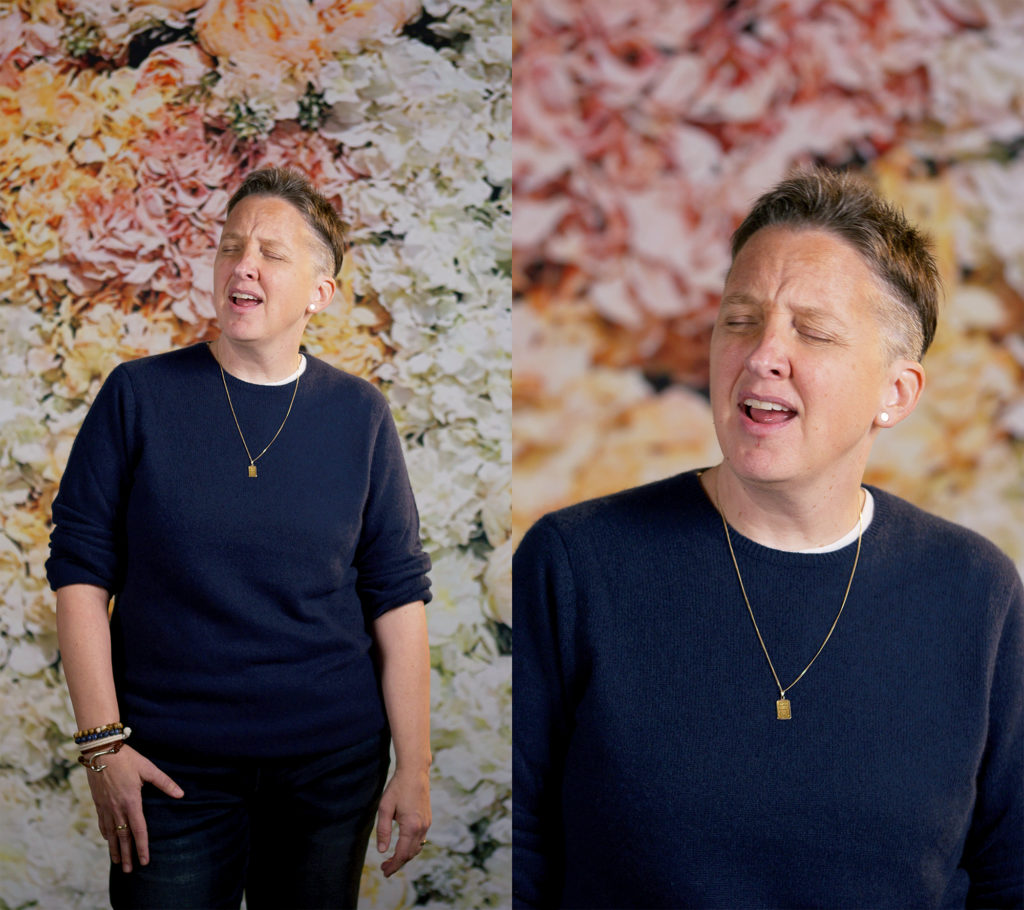
Manders: Speaking of breathing room—that chorus!—why did you choose John Grant’s “Queen of Denmark” for us to perform?
Clarke: It’s the title track from one of my favorite albums. The lyrics resonate, and I enjoy their ambiguity too. The chorus is clearly an address, but to whom? There’s a slippage there that works as both an invitation and provocation. And there’s that drastic change in tempo where the song goes from the melancholic to the soaring. I wanted that drama for us! I also wanted to sing a song by a queer artist, and I’ve appreciated the way that Grant has spoken about gender and queerness in the past. Grant and I might come at the issues in different ways from different lived experiences, but we meet in the song.
Manders: “We meet in the song” is a wonderful and evocative way to describe the individual and collective experience of making Quantum Choir itself, and perhaps the experience of the audience who listens to us. We all meet in the song. That’s part of the experience for the spectators’ bodies, too, how you set up the exhibition space to orient those bodies in certain ways that are maybe uncomfortable and confusing. Many people don’t know where to stand or how to look or listen when they encounter the installation.
Clarke: I’ve been really struggling with the power dynamics of the exhibition space itself. What does it mean to position queer or Black vulnerability in an art gallery for public consumption? There’s a long history of our suffering bodies being used for pure spectacle and entertainment. While I can’t free myself from that history, I don’t want simply to replicate it.
In galleries, a lot of video installations are projected on a wall, and a spectator sits on a bench in front of it and passively consumes the content. For Quantum Choir, I wanted to construct a more active relationship with the spectator—I wanted to ask the spectator to think consciously about their own body in a spatial way while looking at us. I wanted active versus passive viewership. I also wanted to find ways to introduce more opacity into my work. In this case, all four of us are always on screen, but because of the set up, you can never look at all four of us at the same time.
It’s like: I’m going to share my vulnerability with you. I’m going to give you all of this but I’m also going to hold something back. There are moments, too, when auditorily, each of us is holding something back because only three voices or two voices or one voice can be heard. You can never see or hear all of us all at once.

All images courtesy the artist
Manders: It’s a different performance depending on where your body is positioned in the space. Move your body and you necessarily see and hear our bodies differently. And speaking of bodies in space, tell me about the soccer balls and practice pylons on the gallery floor.
Clarke: I wanted to have some kind of intervention in the gallery to support this experiment around asking the viewer to be active. I want the viewers to have to do a little navigational work, to actively orient their own bodies in the gallery space and in relation to us. Not a lot of work, but a little bit of effort in this exchange.
Conceptually, I chose the soccer balls and cones because, for all four of us, sports has been the only consistent place in our lives where our masculinity has been encouraged and supported. While the four of us are in the very center of this gallery doing this hard, vulnerable thing, we’re literally surrounded by these symbols of a safe space for our masculinities.
Manders: Have there been responses to the exhibition that have surprised you?
Clarke: Kids are loving it! I don’t think that I ever considered kids as spectators when I was making this work. They love the soccer balls but are a bit frustrated that they can’t kick them. But the balls are objects that kids run through and by. They are interacting with those aspects of the show in ways that adults don’t.
I think kids like the sonic experience of the song too. Formally, Quantum Choir builds on strategies of intentional repetition, and children respond to that. And I think they respond to the buildup to the song—us doing our different vocal warm-ups.
I also didn’t expect that so many people would cry while watching it. I thought that might happen for people who know us and love us, but it seems to offer a more general sense of release amidst the tension and stress of ongoing pandemic life. After all of this time of being isolated from one another, I can only hope that our collectivity provides some solace.
Michèle Pearson Clarke: Muscle Memory is on view at the Art Gallery of Hamilton, in Hamilton, Ontario, through September 5, 2022.










